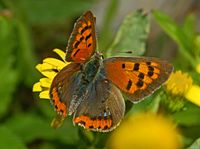- Lycaena phlaeas
-
Small Copper 

Conservation status Not evaluated (IUCN 3.1)Scientific classification Kingdom: Animalia Phylum: Arthropoda Class: Insecta Order: Lepidoptera Family: Lycaenidae Genus: Lycaena Species: L. phlaeas Binomial name Lycaena phlaeas
(Linnaeus, 1761)The Small Copper, American Copper, or the Common Copper (Lycaena phlaeas) is a butterfly of the Lycaenids or gossamer-winged butterfly family.
Contents
Description
The upperside forewings are a bright orange with a dark outside edge border and with eight or nine black spots. The hindwings are dark with an orange border. Some females also have a row of blue spots inside the orange border and are known as form caeruleopunctata. The undersides are patterned in a similar way but are paler. The black spots on the forewings are outlined in yellow and the dark colouring is replaced by a pale brownish, gray. The hindwings are the same brown/grey colour with small black dots and a narrow orange border. The caterpillars (larvae) are usually green, but some have a purple stripe down the middle of the back and along each side.
Range
It is widespread and common across Europe, Asia, and North America, and also found in North Africa south through to Ethiopia.
It can be found almost anywhere in south/central England and Wales although never, it seems, in large numbers. Its distribution becomes more patchy in northern England, Scotland and Ireland.
Habitat
It is found in a wide variety range of habitats from chalk downlands, heathland, woodland clearings to churchyards and waste ground in cities.
Habits
In bright sun it is a very active little butterfly with the males setting up small territories which they will defend vigorously against rival males or indeed any unlucky passing insect. Even the shadow of a large bird passing overhead is enough to get him going. Females are pursued mercilessly and mating usually occurs low down in vegetation.
Life cycle
The eggs are laid singly and conspicuously on the upperside of foodplant leaves and the young caterpillar feeds on the underside of the leaf creating "windows" by leaving the upper epidermis of the leaf untouched. Pupation takes place in the leaf litter and the pupa is thought to be tended by ants. There are between two and three broods a year, fewer further north. In exceptionally good years, a fourth brood sometimes occurs in the south and adults can still be seen flying into November. The species overwinters as a caterpillar.
Host-plants
Depending on the habitat, Common Sorrel (Rumex acetosa) and Sheep's Sorrel (Rumex acetosella) are the two main food-plants, although other Docks (Rumex spp.) are occasionally used.
Systematics
Lycaena phlaeas belongs to the subgenus Thersamolycaena of the genus Lycaena. The species is in turn divided into several subspecies:
- Lycaena phlaeas hibernica — Republic of Ireland, Northern Ireland
- Lycaena phlaeas eleus — England, Wales, Scotland
- Lycaena phlaeas phlaeas — Europe, western Siberia, Caucasus, South Caucasus (type locality = Sweden)
- Lycaena phlaeas polaris — northern Ural Mountains, northern Siberia, Chukotka Peninsula (Russia)
- Lycaena phlaeas kamtschatica — Kamchatka Peninsula (Russia)
- Lycaena phlaeas ganalica — Kamchatka Peninsula (Russia)
- Lycaena phlaeas daimio — south Kurile Islands, Sakhalin (Russian islands)
- Lycaena phlaeas hypophlaeas — Altai Mountains, southern Siberia, Amur (Russia–NW China border region), northern Ussuri (adjacent to Amur)
- Lycaena phlaeas chinensis — southern Ussuri
- Lycaena phlaeas oxiana — Kopet Dag mountains, Alai Mountains, Ghissar-Darvaz, Tian Shan mountains
- Lycaena phlaeas comedarum — eastern Pamir Mountains
- Lycaena phlaeas stygiana — western Pamir Mountains
- Lycaena phlaeas shima — Arabia
- Lycanea phlaeas pseudophlaeas — Ethiopia, Uganda
- Lycaena phlaeas ethiopica — Ruwenzori Mountains (SW Uganda)
- Lycaena phlaeas abbotti — Kenya, Tanzania, Malawi
- Lycaena phlaeas flavens
- Lycaena phlaeas coccinea
- Lycaena phlaeas americana
- Lycaena phlaeas arethusa
- Lycaena phlaeas arctodon
- Lycaena phlaeas feildeni
See also
- Lycaenidae
- List of butterflies of India
- List of butterflies of India (Lycaenidae)
- List of butterflies of Great Britain
References
- Asher, Jim, Martin Warren, Richard Fox, Paul Harding, Gaile Jeffcoate & Stephen Jeffcoate (Eds) (2001) The Millennium Atlas of Butterflies in Britain and Ireland. Oxford University Press.
- Darby, Gene (1958). What is a Butterfly. Chicago: Benefic Press. p. 34.
- Dempster, J.P. & A.M. Emmet (1990) LYCAENA PHLAEAS (Linnaeus). Pp. 134–139 in A. Maitland Emmet, John Heath et al. The Butterflies of Great Britain and Ireland. The Moths and Butterflies of Great Britain and Ireland vol. 7, part 1. Harley Books, Colchester, UK.
- Evans, W.H. (1932) The Identification of Indian Butterflies (2nd Edn). Bombay Natural History Society, Mumbai, India.
- Gaonkar, Harish (1996) Butterflies of the Western Ghats, India (including Sri Lanka) - A Biodiversity Assessment of a threatened mountain system. Journal of the Bombay Natural History Society.
- Gay, Thomas, Isaac Kehimkar & J.C. Punetha (1992) Common Butterflies of India. WWF-India and Oxford University Press, Mumbai, India.
- Haribal, Meena (1994) Butterflies of Sikkim Himalaya and their Natural History.
- Kunte, Krushnamegh (2005) Butterflies of Peninsular India. Universities Press.
- Tomlinson, David & Rob Still (2002) Britain's Butterflies. WildGuides, Old Basing, UK.
- Wynter-Blyth, M.A. (1957) Butterflies of the Indian Region. Bombay Natural History Society, Mumbai, India.
External links
- Lycaena, funet.fi
Categories:- Lycaena
- British butterflies
- Butterflies and moths of North America
- Butterflies of India
Wikimedia Foundation. 2010.









